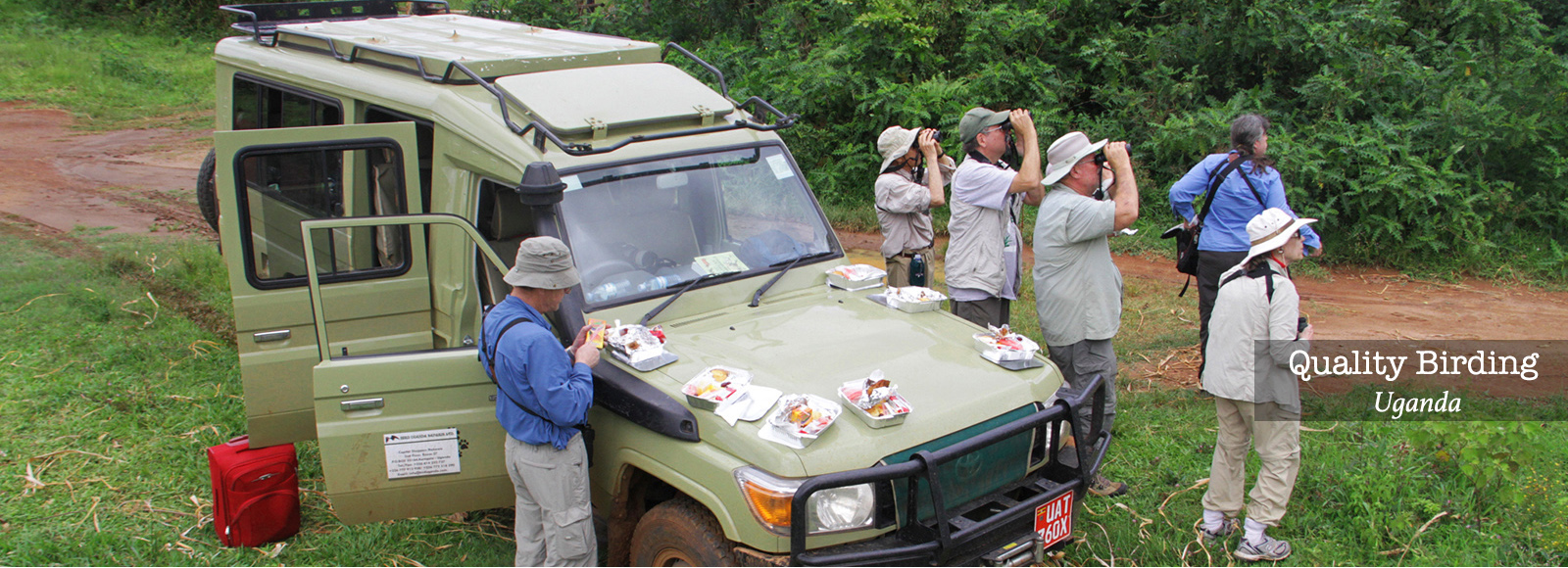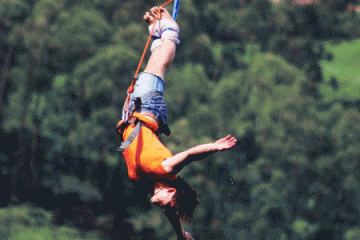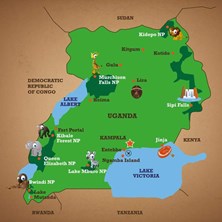Ecologically, Uganda is where the East African savannah meets the West African jungle. Where else but in this impossibly lush country can one observe lions prowling the open plains in the morning and track chimpanzees through the rainforest undergrowth the same afternoon,
then the next day navigate tropical channels teeming with hippo and crocs before setting off into the misty mountains to stare deep into the eyes of a mountain gorilla? Certainly, Uganda is the only safari destination whose range of forest primates is as impressive as its selection of plains antelope. Yet there is more to the country than wildlife – far more!
| START TIME | Please arrive by 7:45 AM. | ||||
| END TIME | Approximately 6:30 PM. | ||||
| WEAR | Comfortable athletic clothing, hiking boots, hat, jacket and sunscreen. | ||||
| INCLUDED |
|
||||
| NOT INCLUDED |
|
Day 1: Arrival at Entebbe Airport.
You will be met by our professional guide at the Entebbe International Airport and transferred to Kampala where you will camp at Backpackers’ Camp.
Day 2: Transfer to Lake Mburo national park. Stay at Mantana Tented Camp or budget campsite for 2 nights.
After breakfast we transfer to Lake Mburo, arriving in the afternoon with a game drive in the park. There is a superb wetland and Acacia savanna sanctuary. Birding here is a delightful experience, with superb scenery and a markedly different fauna to other reserves. This is the best place in the country to see game animals such as Eland as well as Zebra, Topi, Impala, and acacia-associated birds. The lakes within the park attract Hippos, Crocodiles and a variety of waterbirds, while fringing swamps hide secretive papyrus specialists such as Sitatunga, plus much rarer Roan, Leopard, Hyenas and Jackals.
Day 3: Whole day in the Park.
On this day, we have a game drive in the park. Later in the afternoon, we have a boat trip. Look out for mammals like Water Buck, Impala, Eland, Buffalo, Topi, Burchells’ Zebra, Bush Buck, Warthog, and Dwarf Mongoose.
Day 4: Transfer to Bwindi Impenetrable national park. Stay at Buhoma Community Camp for 3 nights.
After breakfast, we have another game drive as we drive out of the park towards Bwindi Impenetrable forest. The Park is an UNESCO World Heritage Site and is home to approximately half of the world population of 600 Mountain Gorillas. This vast reserve offers arguably the most productive montane forest birding in Africa and supports 23 of Uganda’s 24 Albertine Rift endemic bird species. Once part of a much larger forest that included the Virunga Volcanoes in neighbouring Rwanda, Bwindi Impenetrable National Park is now an ecological island within a sea of human cultivation and therefore of immense conservation importance. Buhoma lies in the valley of the Munyaga River at 5100 feet and is flanked by steep, forested hills. Excellent forest birding, not least the prospect of numerous rare and localised Albertine Rift endemics, makes this a true birding Mecca.
Day 5-6: Gorilla Tracking in Bwindi Impenetrable forest, Village walk in the Buhoma Community.
We set off early, with packed lunch, to the park headquarters for a briefing prior to Gorilla Tracking. This is the most exciting lifetime experience of all time. The gorillas are gentle animals and it is an unforgettable experience to photograph them as they interact. It is a wonderful experience to stare in to the eyes of these gentle giants; watch them in awe as they play and go about their daily activities. It is indeed a “once in a lifetime” experience that you must never miss. Each encounter is different and has its own rewards; you are likely to enjoy the close view of adults feeding, grooming and resting as the youngsters frolic and swing from vines in a delightfully playful display.
We also have a village walk around the Buhoma Community. We will visit the Batwa and you will observe their ways of living. The Batwa were given land upon relocation from the forest and most of their basic needs are taken care of. The money they receive out of the village walk is, therefore, used to buy clothes and food. They also use the money from sale of crafts for recreational purposes, reading and buying of alcohol. You will also observe how they go about the process of juice making. We will also visit the traditional healer and you will observe how he treats ailments using tree bark, leaves, and some animal material. He dresses in goat and cow skin to preserve the way traditional healers used to dress. You will also be taken through tea plantations and 10 sites that describe the way of life of the Buhoma Community.
We will spend the balance of our time here looking for other primates like the Lehoist Monkey, Black and White Colobus; Red tailed, and Blue monkeys. Mammals include the Rwenzori Duiker, Yellow back duiker, Caruthers squirrel, Bohm’s and Alexander squirrels, and many other species.
Day 7: Transfer to Queen Elizabeth National Park. Stay at Simba Safari Camp for 2 nights.
We drive to Queen Elizabeth National Park. If conditions are condusive, we will drive through the Ishasha section which is famed for the presence of tree climbing lions. If lucky, you wmy have a view of these magnificent creatures as they bask in the trees. This afternoon upon arrival, we may have an evening game drive in the park. We check in at Mweya Safari Lodge. This Park is from open savannah to rainforest, from dense papyrus swamps and brooding crater lakes to the vastness of Lake Edward, it is little wonder that QENP boasts one of the highest biodiversity ratings of any game reserve in the world. Almost 100 mammal species and a remarkable 6012 bird species make this superb safari territory, with elephant, a profusion of hippos, the elusive giant forest hog and handsome Uganda kob all regularly sighted around the tourist village on the Mweya Peninsula – which also boasts of a marvelous waterfront setting in the shadow of the Rwenzori Mountains.
Day 8: Game Drive in the park and Launch Cruise on the Kazinga Channnel.
We start early at dawn with an early cup of coffee and go for a game drive to look for the big game and beautiful sceneries. This afternoon, after our lunch at the lodge, we have a boat cruise on the spectacular Kazinga Channel. Back for dinner at the campsite.
Day 9: Transfer to Kibale National Park. Stay at budget campsite for 2 nights.
Today we transfer to Kibale forest. We carry our packed lunch which we shall enjoy on the way. Check in at Ndali Lodge. Kibale’s major attraction, however, is the opportunity to track habituated chimps – these delightful apes, more closely related to humans than to any other living creature, are tremendous fun to watch as they squabble and play in fruiting trees. A network of shady forest trails provides much to delight botanists and butterfly lovers, while birders are in for a treat with 335 species. The elusive forest elephant, smaller and hairier than its savannah counterpart, moves seasonally into the developed part of the park, while other terrestrial mammals include buffalo, giant forest hog and a half dozen antelope species.
Day 10: Chimp tracking at Kibale National Park.
We start after a dawn breakfast, carry packed lunch and go to the forest for chimp tracking. Tracking the chimpanzee that is our ‘cousin’ is a very interesting experience. The way they feed, climb trees, respond to humans, caring for their young ones, is just phenomenal. This is a drama of life in a rain forest. This park is notable for its primate population, with the chimpanzees being the most famous. In the afternoon, if time allows, it will be possible to have a nature walk at Bigodi wetland which is managed by the community. This demonstrates a successful story of the ecotourism development benefits. Overnight at Ndali Lodge.
Day 11: Transfer to Murchison Falls National Park. Stay at Red Chilli camp site for 3 nights.
After breakfast, we drive northwards to Murchison Falls National Park stopping for lunch at Masindi Hotel. We later cross the River Nile and check-in at Paraa Safari Lodge. Murchison Falls Conservation area (MFNP) comprises of Bugungu and Karuma Wildlife Reserves. It derives its name from the Murchison Falls where the mighty River Nile explodes through a narrow gorge and flows down to become a placid river whose banks are thronged with hippos, crocodiles, waterbucks and buffaloes. The vegetation is characterized by savannah, river line forest and woodland. Wildlife includes lions, leopards, elephants, giraffes, buffaloes, hartebeest, oribis, Uganda kobs, chimpanzees and many bird species including the rare shoebill.
Day 12: Game Drive in Murchison Falls national park.
We start after an early breakfast and go for a whole morning game drive in the delta area. We will have lunch at the camp. We later take the afternoon launch cruise to the bottom of the falls. This brings us to the closest distance to the magnificent falls. Dinner at the camp.
Day 13: Game Drive in Murchison Falls national park.
After breakfast, we again have another chance to enjoy viewing the big game in the largest conservation area in Uganda. Lunch at the camp. Another game evening game drive will may offer opportunities of Nocturnal species of wildlife.
Day 14: Transfer to Budongo for chimpanzee tracking at Kanio Pabide. Stay at bush campsite.
We start early after our breakfast and head for Budongo forest Kanio Pabide section. We have a forest walk in search of chimpanzee our close cousins. Budongo forest is known for the highest populations of Chimpanzees in the tropical Africa. We have dinner and overnight stay at Masindi Hotel.
Day 15: Transfer to Kampala. Stay at Backpackers’ Campsite.
On this day, we transfer to Kampala carrying along a packed lunch later to be enjoyed on the way.
Day 16: Transfer to Entebbe Airport for departure.


